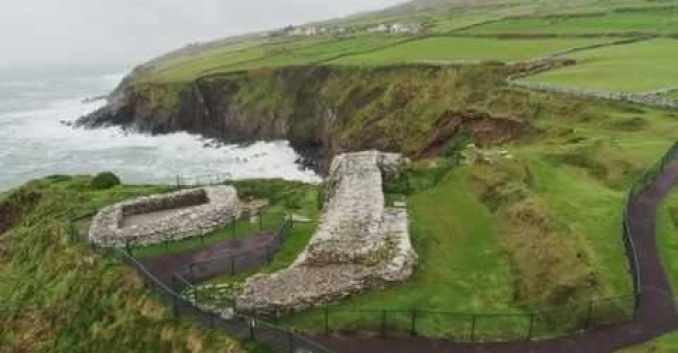Dún Beag Fort - An Dún Beag

Dún Beag Fort (Irish: An Dún Beag) is an Iron Age promontory fort dated to 500 BC. The Iron Age period in Ireland is mainly given a date of starting at approximately 500BC. Although the National Museum of Ireland points out that ironworking may have been known from as early as the eighth century BC in parts of Ireland. However, they make the point that it was not until around the third century BC that a distinctive Iron Age society emerged.
Dún Beag Fort is located on a rocky promontory just south of Slea Head (Irish: Ceann Sléibhe) on the Dingle Peninsula (Irish: Corca Dhuibhne). It is in the Fahan area near the village of Ventry in County Kerry, Ireland (Irish: Irish: Fionntrá, Contae Chiarraí, Éire). The fortification is built on the edge of a cliff for maximum protection. On the land side there are a number of earth walls and a large rampart to provide additional defence. Close to the fort there is a group of clocháns, which are dry-stone huts with a corbelled roof small stone structures also known as beehive huts. They have been estimated to have been built around 1000 BC.
Since Dún Beag Fort was first constructed it has been subject to coastal erosion and portions of the structure have been lost. It continues to be threatened to loss to the sea, particularly during heavy seasonal storms. This has resulted in the fort being closed for periods over the years for remedial work by Ireland's Office of Public Works (OPW) (Irish: Oifig na nOibreacha Poiblí). There is visitor centre at the site that has audiovisual displays, an information and craft room and a restaurant and café.
Link: Dingle Penisula Dún Beag Fort Visitors Centre.
Image: Image: Courtesy Office of Public Works (OPW) (Irish: Oifig na nOibreacha Poiblí) Facebook page
Celtic nation:
- Ireland
Itinerary:
- Ireland Munster west
Place type:
- Ancient site





